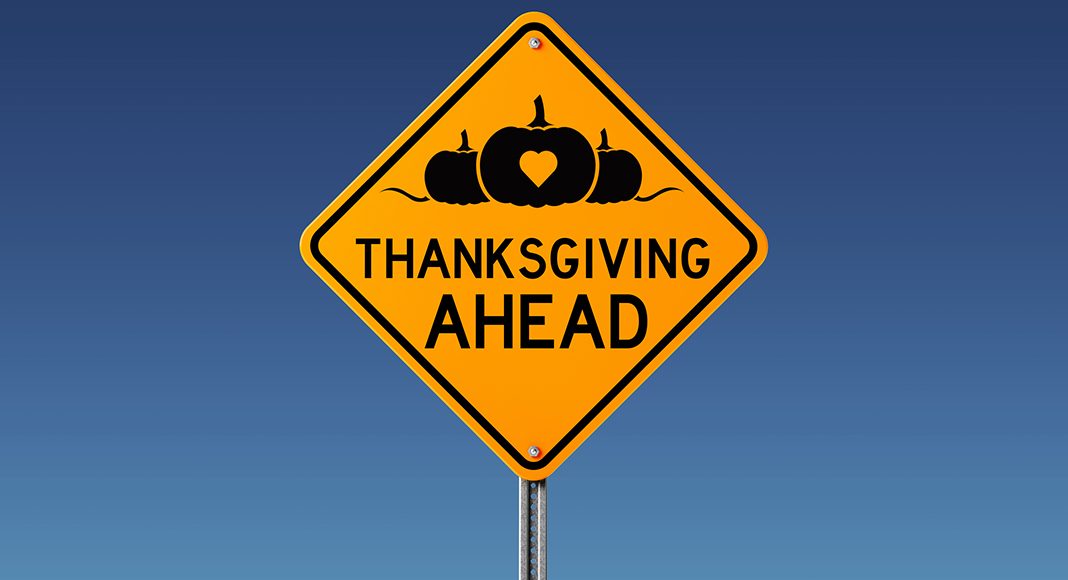With millions of Americans on the countdown to Thanksgiving, now is the time to plan for safe holiday travel.
Thanksgiving is one of the busiest travel times of the year, increasing the potential for collisions on the road. In 2016, 341 people were killed in motor vehicle crashes over Thanksgiving weekend (Wednesday to Monday). Almost half of those people (49 percent) were not buckled up. And more than half of the crashes (55 percent) occurred at night.
This year, the AAA is predicting the highest Thanksgiving travel volume since 2005, with 48.5 million Americans planning a Thanksgiving road trip â nearly five percent more than last year.
INRIX, in collaboration with AAA, predicts drivers will experience the greatest amount of congestion Thanksgiving week during the early evening commute period, with travel times starting to increase on Monday.
âThanksgiving is one of the busiest holidays for road trips, and this year will be no different,â said Trevor Reed, Transportation Analyst at INRIX. âKnowing when and where congestion will build can help drivers avoid the stress of sitting in traffic. Our advice to drivers is to avoid commuting times in major cities altogether or plan alternative routes.â
Planning ahead can make all the difference to safe travel so here are ten driving tips for a safe and happy Thanksgiving.
1. Get your vehicle ready
Do this far enough in advance that you can take action where necessary. Check fluid levels, fuel, lights, tire pressures, tire condition, brakes, battery and wiper blades. Consult a professional if youâre unsure how to carry out the checks. Pack an emergency kit that includes a blanket, deicer, water, non-perishable food, car charger for your phone, warning triangle, basic first-aid kit, flashlight.
 2. Plan the best time to travel
Avoid traveling during peak times if you can. INRIX says that, in most cases, the best days to travel will be on Thanksgiving Day, Friday or Saturday. Drivers should expect increased travel times on Sunday as most holiday travelers will be making their way home after the long weekend.
Check the weather forecasts and travel updates before you leave. Put off traveling if conditions are bad (see eDrivingâs winter driving safety tips). Let friends/ family know your travel plans and estimated time of arrival.
3. Load your vehicle sensibly
No doubt youâll have lots to take with you on your Thanksgiving trip but itâs important to pack with care. Donât overload your vehicle as doing so can affect its suspension, handling and braking capabilities. You should be able to check maximum weight limits on a sticker inside the driverâs door or in your ownerâs manual.
- Make sure no items are in â or behind â the driverâs footwell. Be aware that items in the rear footwell could slide forward while the vehicle is in motion
- Avoid stacking items on a parcel shelf or anywhere that they could be projected forward in the event of a collision
4. Plan a distraction-free trip
- Pack a selection of quiet activities to occupy younger passengers â such as books, games consoles or DVD players (with headphones)
- Put your phone away before you set off to avoid the temptation to look at it while driving. Or, give it to a fellow passenger for them to receive calls/ texts for you
- Talk to passengers before you set off about the importance of you giving the road your full attention
- Set up GPS before starting your trip and avoid eating and drinking during the drive
5. Drive well-rested
Get plenty of rest before you set off so you can remain alert throughout your journey. Driving while tired affects driving ability in the same way as drinking alcohol; it reduces reaction times and affects concentration and co-ordination. Allow plenty of time for a good nightâs sleep before you set off â and take regular breaks from driving â at least 15 minutes every two hours.
6. Buckle up
Make sure everyone in the vehicle wears a seatbelt, every trip. Ensure children are seated in appropriate seats â check requirements here.
7. Watch your speed
Speeding reduces your reaction time in an emergency and increases the force of a collision. Travel at a speed that enables you to safely stop in the distance you can see to be clear, and remember that a three-second following distance is for good conditions only.
8. Look out for others, including truck drivers
Drivers of larger vehicles are often the victims of other driversâ anger and frustration. Their size might make them look invincible to other vehicles, but that size can actually be a stressful detriment to a truckerâs driving experience. Take steps to let the trucker know youâre passing them â this includes keeping your turn signal on longer than normal and making 100 percent sure the truck is clear of your vehicle before changing lane.
9. Keep an eye on in-car valuables
In 2017, many police forces across the country reported record levels of vehicle break-ins. When stopping for a break mid-road trip, let travelers leave the vehicle in shifts so that someone is always present. Once youâve reached your destination, be sure to remove everything of value inside. Check twice to be certain.
10. Avoid alcohol if driving
Donât drive at all if youâve consumed any alcohol. Keep the âmorning after effectâ in mind while celebrating over the holiday period. And look out for friends and colleagues too. If you know someone has been drinking, donât let them drive. Call them a taxi, arrange a lift with a sober friend or encourage them to stay over for the night.
Have a safe, happy Thanksgiving!



















